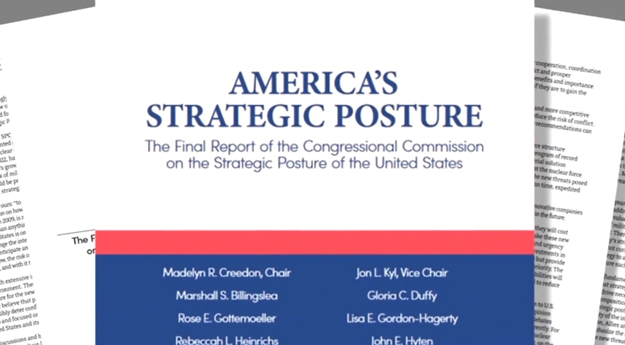Part 3 of 3 Parts (Please read Parts 1 and 2 first)
Despite the impossibility of even Russia's and China's combined nuclear forces launching a successful first strike which would knock out the United States' ability to cause catastrophic damage in response, the U.S. might be headed for increases in its nuclear forces.
The Strategic Posture Commission's report on preparing for threats from 2027 through 2035 states that the U.S. nuclear force must be “either larger in size, different in composition, or both” if it is to be able to address both a revisionist Russia and a China that the report claims is “pursuing a nuclear force buildup on a scale and pace unseen since the U.S.-Soviet nuclear arms race that ended in the late 1980s.”
The commission's report goes on to recommend that the U.S. urgently send more nuclear warheads to its deployed carriers, deploy, or base nuclear forces to the Asia-Pacific theater, increase planned numbers of nuclear-capable bombers, investigate fielding road-mobile nuclear missile carriers and prepare to deploy the future Sentinel ICBM in a configuration that carries multiple independent re-entry vehicles. Currently, each Minuteman III ICBM only carries one warhead, because of limits imposed by New START.
Russia is also pouring resources into upgrading its nuclear arsenal, with a recent test of a new type of heavy ICBM, the RS-28 Sarmat, apparently having failed.
The Sarmat is one of six weapons that Putin revealed at his 2018 annual address. A video animation showed Russian missiles flying toward a target resembling Florida. Two U.S. analysts recently claimed to have found a likely deployment site for another one of Russia's nuclear-capable weapons heralded by Putin in 2018, the Burevestnik. Russia has also suggested that it may resume nuclear testing, preparing facilities on the island of Novaya Zemlya, where the Soviet Union tested the largest nuclear bomb ever detonated.
Putin on September 25 proposed broadening the scope of Russia's nuclear doctrine, suggesting that attacks by "nonnuclear countries with the participation or support of a nuclear country" could trigger a nuclear response, in a clear reference to Ukraine and its Western backers. The same day, China launched a nuclear-capable ICBM into the Pacific Ocean, its first ICBM test outside of its territory in over 40 years.
Besides potentially sending nuclear warheads to existing carriers and developing new weapons systems, the U.S. recently announced it would deploy nonnuclear cruise missiles that would previously have been banned under the INF treaty to Germany, with Putin promising to respond in kind and lift a self-imposed moratorium on deploying intermediate-range missiles if the deployments go ahead.
It has been reported that Russia has deployed nuclear weapons in Belarus, which had not hosted them since the early 1990s.
With many changes to nuclear and conventional missile force postures taking place, relations between the West and Russia and China have sunk to their lowest point since the Cold War. With more countries building up significant stockpiles of nuclear warheads, the world could already be living through the beginning of the next nuclear arms race. If the nuclear powers don't agree on new limits, it could be just as dangerous as the last one.
